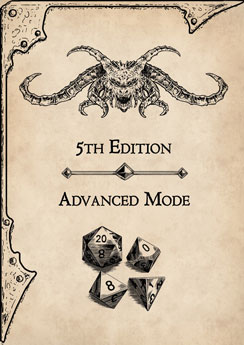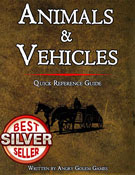Medium monstrosity, unaligned
Armor Class 14 (Natural Armor)
Armor Class (suggested) 17 (Natural Armor)
Hit Points 27 (5d8+5)
Speed 40 ft. (suggested 60 ft.)
Proficiency Bonus +2
Proficiency Bonus +3 (5th Edition Advanced Mode)
| STR | DEX | CON | INT | WIS | CHA |
|---|---|---|---|---|---|
| 14 (+2) | 20 (+5) | 13 (+1) | 2 (-4) | 13 (+1) | 6 (-2) |
Saving Throws (suggested) Dex +7
Senses Darkvision 60 ft., passive Perception 11
Challenge 1/2 (100 XP)
Iron Scent. The rust monster can pinpoint, by scent, the location of ferrous metal within 30 feet of it.
Metal Scent (suggested). The rust monster can pinpoint, by scent, the location of ferrous metal within 90 feet of it.
Rust Metal. Any nonmagical weapon made of metal that hits the rust monster corrodes. After dealing damage, the weapon takes a permanent and cumulative -1 penalty to damage rolls. If its penalty drops to -5, the weapon is destroyed. Non magical ammunition made of metal that hits the rust monster is destroyed after dealing damage.
Rust Metal (suggested). Any weapon, magical or nonmagical, made of metal that hits the rust monster corrodes. After dealing damage, the weapon takes a permanent and cumulative -1 penalty to damage rolls. If its penalty drops to -5, the weapon is destroyed. Non magical ammunition made of metal that hits the rust monster is destroyed after dealing damage. Magical weapons are entitled a DC 11 saving throw to resist the effect; the magical weapon add its magical bonus modifier and the wielder dexterity bonus to the saving throw. If the saving throw fails, the magical weapon permanently loses one point of magical bonus.
ACTIONS
- Multiattack (suggested). The rust monster makes two attacks with its antenna or one attack with its bite.
- Bite. Melee Weapon Attack: +3 to hit, reach 5 ft., one target. Hit: 5 (1d8 + 1) piercing damage.
- Bite (suggested). Melee Weapon Attack: +3 to hit, reach 5 ft., one target. Hit: 3 (1d4 + 1) piercing damage.
- Antennae. The rust monster corrodes a nonmagical ferrous metal object it can see within 5 feet of it. If the object isn’t being worn or carried, the touch destroys a 1-foot cube of it. If the object is being worn or carried by a creature, the creature can make a DC 11 Dexterity saving throw to avoid the rust monster’s touch.
If the object touched is either metal armor or a metal shield being worn or carried, its takes a permanent and cumulative -1 penalty to the AC it offers. Armor reduced to an AC of 10 or a shield that drops to a +0 bonus is destroyed. If the object touched is a held metal weapon, it rusts as described in the Rust Metal trait. - Antennae (suggested). Melee Weapon Attack: +7 to hit, reach 10 ft., one metal object. Hit: – (-). The rust monster corrodes a nonmagical ferrous metal object it can touch. If the object isn’t being worn or carried, the touch destroys a 1-foot cube of it. If the object is being worn or carried by a creature, the creature can make a DC 15 Dexterity saving throw to avoid the rust monster’s touch. If the object touched is either metal armor or a metal shield being worn or carried, its takes a permanent and cumulative -1 penalty to the AC it offers. Armor reduced to an AC of 10 or a shield that drops to a +0 bonus is destroyed. If the object touched is a held metal weapon, it rusts as described in the Rust Metal trait.
RUST MONSTER’s TACTICS (read the article)
5th Edition Advanced Mode
Limiting the power of a character and making the overall difficulty of the game harder, does not reduce the creativity, indeed it does quite the opposite.
The Game Master has the option to use any and all of the instances proposed in this guide, or just some of them according to their preference.
It is the lack of something that move and motivate characters, not the abundance of it
DESCRIPTION
The rust monster resembles a large, shaggy insect with a pair of long antennae and a segmented tail. Its body is covered in brown fur, and its eyes are small and black. The tail ends in an odd-looking bony projection that resembles a double-ended paddle. The hide of the rust monster is rough, covered with lumpy projections. The average rust monster measures 5 feet long and 3 feet high at the shoulder. The rust monster can smell metal from a distance, and will pursue any source of ferrous metal with relentless hunger. It can corrode metal objects with a touch of its antennae, reducing them to rust in seconds. The rust monster is not inherently hostile, but will defend itself if attacked or prevented from reaching its meal.
COMBAT
The rust monster is not a formidable combatant, relying on its speed and agility to evade enemies. It prefers to avoid direct confrontation, unless it senses metal on its foes. In that case, it will try to reach the metal object and corrode it with its antennae, ignoring any other attacks. The rust monster can also bite with its mandibles, but this is a secondary option. The rust monster’s greatest weakness is its vulnerability to non-metallic weapons, such as wood, stone, or bone. It also has no resistance to magic, and can be easily harmed by spells or enchanted items. Metal weapons striking a rust monster are affected just as if the creature’s antennae had touched them. Rust monsters, being none too bright, stop pursuing a fleeing party for one round to devour metallic items, such as a handful of iron spikes, a mace or a hammer, if the party throws them behind. Rust monsters go after ferrous metals such as iron, steel, and magical steel alloys, such as mithril and adamantite. They choose such metals over valuable metals. In fact, they would continue to pursue a party that just dropped a fistful of copper coins, for example, in hopes of getting the much-preferred ferrous metal of armor and weapons.
HABITAT / SOCIETY
The rust monster is a solitary creature that wanders the dark and damp places of the world, such as caves, dungeons, sewers, or ruins. It has no lair or territory, and will move on once it has exhausted the metal sources in an area. The rust monster has no language or culture, and does not communicate with other creatures. It does not mate or reproduce, but instead spawns new rust monsters from the remains of its metal meals. The rust monster is not affected by the alignment or morality of its prey, and will consume any metal object regardless of its origin or value. Rust monsters dwell only in dark, subterranean places such as caverns and underground structures. They are not disposed to groups; often a lair comprises one or two rust monsters, with a 5% chance of encountering a single offspring, which acts as a half-strength rust monster with a full-strength appetite. These creatures have been known to range the length and breadth of an underground complex, searching for supplies of metal. Though it will eat raw ore, a rust monster always prefers the refined, forged metal (just as a human would prefer fresh, filtered water over swamp water). The creature’s relatively inoffensive nature makes it an unlikely target. There have been many accounts of mages approaching a rust monster and the only reaction from the beast was a cursory sniff, then a leisurely departure. Dwarves and gnomes, known for metalworking and mining, have no sympathy for rust monsters, and will do anything to get rid of them.
ECOLOGY
The rust monster plays a unique role in the ecosystem, as it recycles metal into organic matter. The rust monster’s fur and flesh are rich in iron and other minerals, which can be used by plants and animals as nutrients. The rust monster also creates rust dust, which can fertilize the soil or be used as a pigment by some creatures. The rust monster has few natural predators, as most animals avoid its metallic scent and taste. However, some creatures have learned to exploit the rust monster’s weakness, such as mimics that lure it with false metal objects, or oozes that dissolve its fur and flesh. The rust monster is also hunted by some humanoids, who value its fur for its durability and warmth.
The only treasure to be found in a rust monster lair is gems, usually the sort used for decoration on armor or sword pommels. Rust monsters have no grand designs, only the wish to keep well-fed.
Rust Monsters can be used as mounts or pulling animals for vehicles.
The statistics are detailed in the D&D 5e Animals & Vehicles reference guide. Just have a look at the preview on DrivethruRpg.

